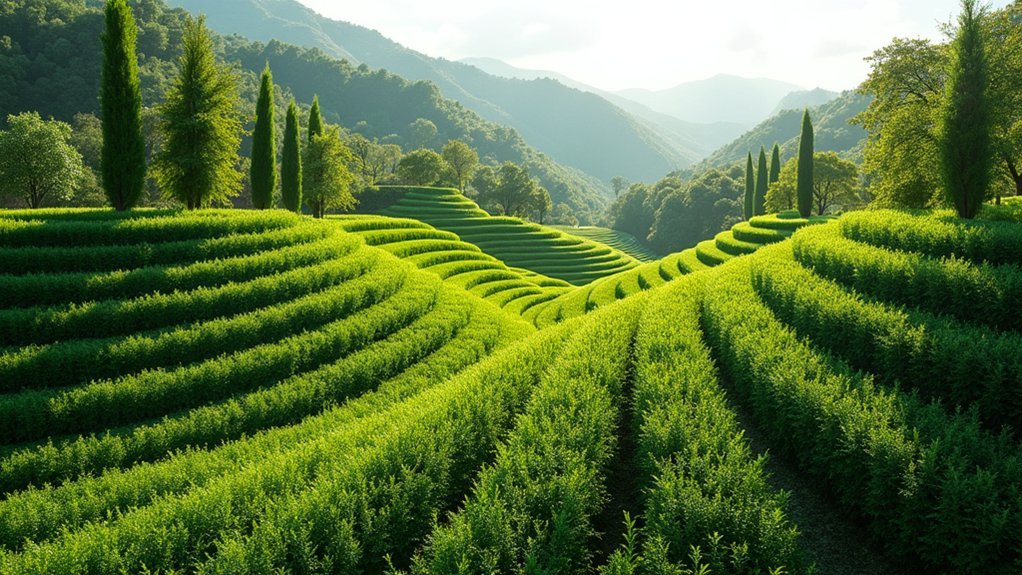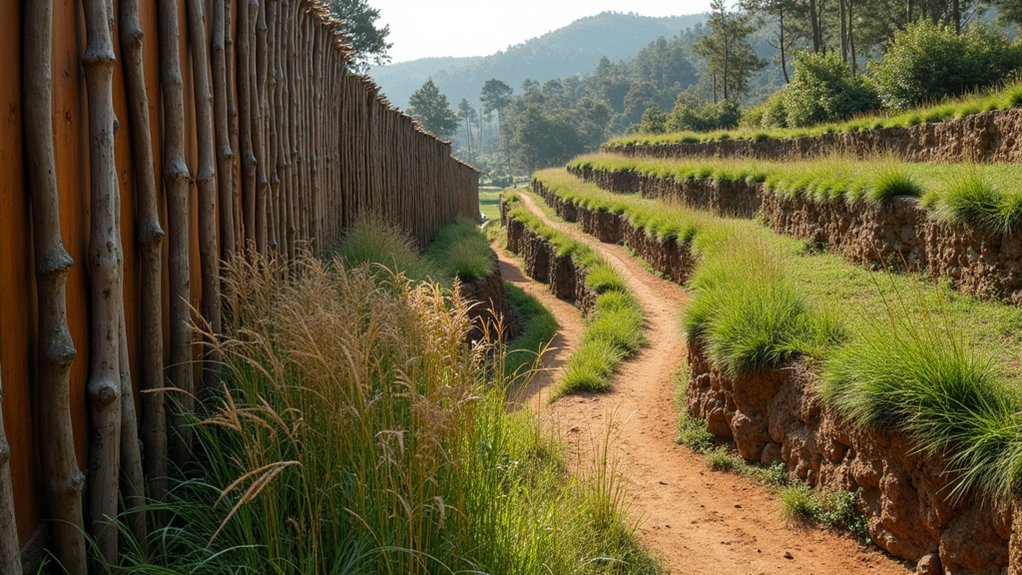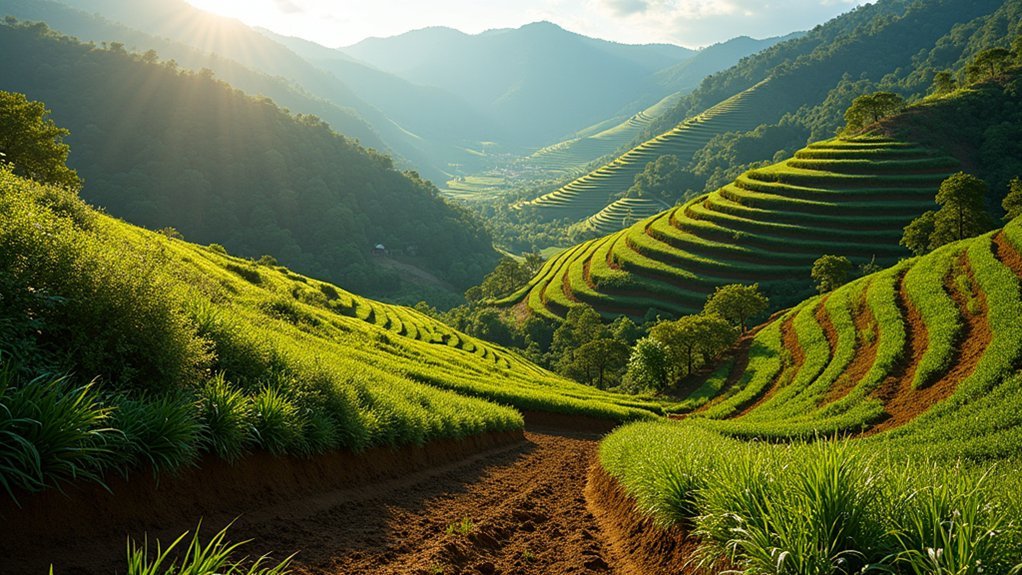Building effective terraced windbreaks requires three key techniques: strategic placement of tall plants at 45-degree angles to prevailing winds, creating multi-level protection with tiered planting zones spaced 1-3 feet apart, and integrating structural elements like trellises with natural materials for thorough defense. You’ll want to combine evergreen and deciduous species, prioritizing native plants for low maintenance and ecological benefits. These approaches not only protect your property but create a beautiful, functional landscape that thrives year-round.
Strategic Placement of Tall Plants for Maximum Wind Deflection

When designing your terraced windbreak, positioning tall plants at a 45-degree angle to prevailing winds creates ideal deflection patterns.
Select species that will grow at least 2-3 times higher than surrounding vegetation to effectively redirect wind currents away from your protected areas.
Arrange your tall plants in a staggered formation to build multiple layers of wind resistance. This configuration greatly reduces wind speed while maintaining proper air circulation.
Space plants approximately one and a half times their mature height apart to guarantee they don’t become overcrowded.
For year-round wind protection, combine evergreen and deciduous tall plants in your windbreak design.
Evergreens offer consistent shelter during winter months, while deciduous varieties provide seasonal beauty and wildlife habitat while contributing to your windbreak’s effectiveness during growing seasons.
Creating Multi-Level Protection With Tiered Planting Zones
Though single-height barriers offer basic protection, multi-level tiered planting zones dramatically enhance your windbreak’s effectiveness. When properly designed, these tiers can reduce wind speeds across an area extending 20-30 times the height of your tallest plants.
Arrange your landscape design with taller species at the back, creating a primary shield against strong winds, while shorter plants and climbing plants fill lower zones. Space plants 1-3 feet apart—close enough for dense protection but allowing healthy growth.
For year-round defense against soil erosion and harsh conditions, combine evergreens and deciduous varieties throughout your outdoor space. Native species work exceptionally well in effective windbreaks, requiring less maintenance while supporting local wildlife.
Their natural adaptation to your region’s climate guarantees stronger performance in all seasons.
Integrating Structural Elements With Natural Materials

Creating effective windbreaks often requires more than vegetation alone, which is why combining structural frameworks with natural materials delivers superior protection and aesthetic appeal.
Structural frameworks paired with strategic plantings create windbreaks that protect beautifully while seamlessly integrating into your landscape design.
As a landscape designer, you’ll find that merging wooden trellises or composite frames with climbing plants creates windbreaks that both diffuse wind and enhance your outdoor spaces.
- Structure + Plants – Install durable composite or wooden frames as your windbreak backbone, then incorporate wind-resistant plants that thrive in your climate.
- Height Optimization – Position taller structural elements centrally with shorter components radiating outward to maximize wind diffusion across your space.
- Erosion Control – Integrate stones and soil with your structural elements to manage erosion while promoting biodiversity and creating a seamless connection into your landscape.
Frequently Asked Questions
How to Construct a Windbreak?
To construct a windbreak, you’ll need permits first, then select durable materials like wood or composite. Install in a triangular layout with tall elements in the center, and incorporate dense plants for both protection and appearance.
What Is the Reason for Techniques Such as Windbreaks No Till Farming and Terracing?
You’ll use windbreaks, no-till farming, and terracing to protect your soil from erosion, retain moisture, improve crop yields, and create stable microclimates. They’re complementary techniques that enhance biodiversity and promote sustainable agricultural practices.
What Is the Most Important Factor in Determining a Windbreaks Downwind Area of Protection?
The height of your windbreak’s tallest trees is the most important factor determining its downwind protection area. You’ll typically see protection extending 20-30 times the height of these trees.
How Do Terracing and Planting Windbreaks Help Reduce Soil Erosion?
You’ll reduce soil erosion by combining terraces and windbreaks. Terraces slow water runoff on slopes, while windbreaks shield soil from wind damage. Together, they’ll trap moisture, stabilize soil with roots, and cut erosion by 50%.
In Summary
You’ve now learned three key techniques for building effective terraced windbreaks. By strategically placing tall plants, creating multi-level protection through tiered zones, and integrating structural elements with natural materials, you’ll shield your property from harsh winds. These methods work together to form a thorough wind barrier that’s both functional and aesthetically pleasing. Start implementing these approaches, and you’ll soon enjoy a more protected outdoor space.





Leave a Reply